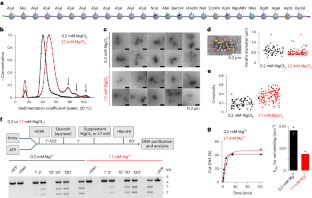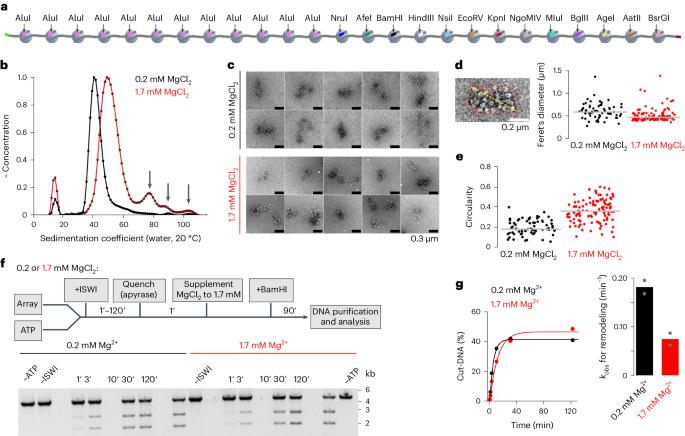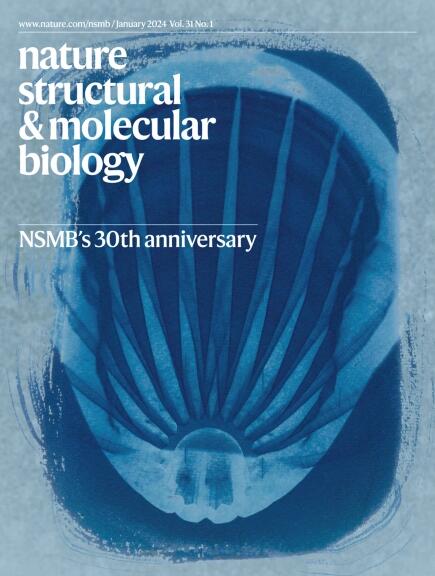ISWI 催化凝聚核糖体阵列中的核糖体滑动
IF 12.5
1区 生物学
Q1 BIOCHEMISTRY & MOLECULAR BIOLOGY
引用次数: 0
摘要
染色质酶如何在凝聚的染色质中工作,以及它们如何保持染色质内部的扩散流动性,这些问题仍有待探索。在这里,我们利用果蝇的 ISWI 重塑 ATP 酶研究了这些难题,该酶可使核小体沿 DNA 滑动。染色质纤维的折叠并不影响体外滑动。染色质凝聚体内外的催化率也相当。除了 ATP 水解可能发生的情况外,ISWI 会交联,从而使凝集物变硬。ISWI 在凝聚体中的流动性也需要活性水解。因此,ATP水解产生的能量可促进ISWI在染色质中的扩散,并阻止ISWI交联染色质。在 "猴条 "模型的分子动力学模拟中,ISWI先抓住相邻的核小体,然后以依赖于ATP水解的方式从一个核小体中撤出,再重新与另一个核小体结合。我们推测,"猴条 "机制可能与其他染色质因子共享,重塑因子突变导致的染色质动力学变化可能导致病变。本文章由计算机程序翻译,如有差异,请以英文原文为准。


ISWI catalyzes nucleosome sliding in condensed nucleosome arrays
How chromatin enzymes work in condensed chromatin and how they maintain diffusional mobility inside remains unexplored. Here we investigated these challenges using the Drosophila ISWI remodeling ATPase, which slides nucleosomes along DNA. Folding of chromatin fibers did not affect sliding in vitro. Catalytic rates were also comparable in- and outside of chromatin condensates. ISWI cross-links and thereby stiffens condensates, except when ATP hydrolysis is possible. Active hydrolysis is also required for ISWI’s mobility in condensates. Energy from ATP hydrolysis therefore fuels ISWI’s diffusion through chromatin and prevents ISWI from cross-linking chromatin. Molecular dynamics simulations of a ‘monkey-bar’ model in which ISWI grabs onto neighboring nucleosomes, then withdraws from one before rebinding another in an ATP hydrolysis-dependent manner, qualitatively agree with our data. We speculate that monkey-bar mechanisms could be shared with other chromatin factors and that changes in chromatin dynamics caused by mutations in remodelers could contribute to pathologies. Chromatin condensation does not impede nucleosome sliding by ISWI remodelers. Notably, ATP energy is used not only for remodeling but also for enzyme mobility and to prevent solidification of chromatin. A ‘monkey-bar’ model rationalizes the findings.
求助全文
通过发布文献求助,成功后即可免费获取论文全文。
去求助
来源期刊

Nature Structural & Molecular Biology
BIOCHEMISTRY & MOLECULAR BIOLOGY-BIOPHYSICS
CiteScore
22.00
自引率
1.80%
发文量
160
审稿时长
3-8 weeks
期刊介绍:
Nature Structural & Molecular Biology is a comprehensive platform that combines structural and molecular research. Our journal focuses on exploring the functional and mechanistic aspects of biological processes, emphasizing how molecular components collaborate to achieve a particular function. While structural data can shed light on these insights, our publication does not require them as a prerequisite.
 求助内容:
求助内容: 应助结果提醒方式:
应助结果提醒方式:


